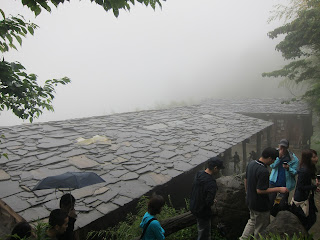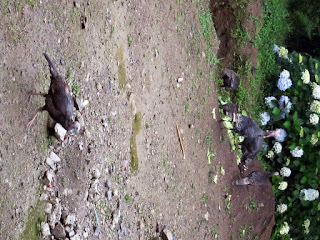Smangus - From the Black Tribe to the God's Tribe
We departed Taipei for Smangus at 8am, since it takes quite some time to get there, especially the 2-hour bumpy industrial road between the checking point and the tribe.
Neiwan (內灣)
 |
| Neiwan Train Station |
According to Wikipedia, the characteristic of Neiwan should be the buildings of the old town, where the houses are built with red bricks as the bases and the pillars, and then with wood as the materials of the house body. However, now you will probably never realize when you finish a trip to Neiwan as there is no clue of it from the tourist information -- This is such a pity.
 |
| Neiwan Old Town |
 |
| The renovated old Neiwan Theatre now as a restaurant |
 |
| lk-Buta, the heroic figure of Atayal as a pioneer who discovered the mountains near the Snow Mountains (雪山山脈) as the new home for his people. |
Smangus (司馬庫斯)
After hours of bumpy ride, we saw an empty toll gate where a greeting is written: "歡迎光臨上帝的部落司馬庫斯" ("Welcome to God's Tribe, Smangus!"). In the rain, here we finally came to the mythical tribe finally.
There is a tourist information centre right to the left of the entry, which also functions as the reception of the accommodation there. The check-in of our suite should be 3pm, but we were allowed to check in immediately as the room was already available. As a suite of NTD 2,500, the room seems too humble without any renovation. But we didn't expect too much anyway as this is such a remote place -- And the room was quite neat and clean indeed. After taking a short break, we gathered at the information centre for the free tribal tour from 3:30pm.
 |
The beautiful school would be a good place for exchange
programme for those students from big cities, the guide
joked.
|
There are two possible origins of the tribe's name, Smangus. It could be from the name of the Atayal pioneer, Makus, who became the first to come to Smangus and established the tribe. The second origin is from the abundant Bangus (Quercus semecarpifolia) around the area.
 |
| Christmas decorations of the school -- 100% of the tribal population are Catholic. |
 |
| Our tour guide in the traditional costume of the Atayal people. |
 |
| Skun khu', "the Granary" for millet, of the Atayal is built on stilts to keep the grains dry. |
 |
| The Atayalic wooden carvings in Smangus. |
 |
| The funnel-shaped street lamp can be seen all around the village. |
 |
| Turkeys |
 |
| "La qi klokah", the greeting in the Atayal language. |
 |
| A watchtower for security. It used to be that only men were allowed to climb the tower. |
 |
| Qeqiy, "Two Trees of Husband and Wife" |
 |
| Smangus' only church |
In the party, all the visitors were amused with the performances of the tribal people, e.g. the folk and modern songs in the Atayal language (and very few in Chinese Mandarin), and the traditional jaw harp playing by the deputy head of Smangus; at the same time, as an atheist, I needed to try to be open-minded whenever we were asked to sing songs to hail to Jesus Christ.
As all the tribal population is catholic, any religious thing becomes very important in Smangus. This can be observed from the importance of the church and also the organizational structure of Tnunan, in which the Catholic father is one of the top positions.
 |
| The deputy head of Smangus, explaining the system of Tnunan and then performed the traditional jaw harp of the Atayal for the audience. |
No comments:
Post a Comment